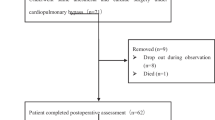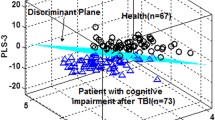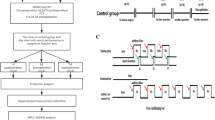Abstract
Postoperative cognitive dysfunction (POCD) is a subtle cognitive dysfunction, especially memory impairment for weeks or months after surgery. The underlying pathophysiological mechanism of POCD is still unclear. The aim of this study was to exploratively investigate the potential mechanism of POCD by identifying the differences among metabolic profiles of control rats, POCD and no-POCD rats after isoflurane anesthesia based on GC–MS, and subsequently discovering POCD biomarkers. In this paper, a feature-variable selection method, subwindow permutation analysis (SPA), was employed to seek the key metabolites distinguishing POCD from control group, POCD from no-POCD group. Fortunately, two key metabolites, hexadecanoic acid and myo-Inositol, were both screened out for discriminating POCD and control, POCD and no-POCD rats. It suggested that they may reveal the disturbances between POCD and control, POCD and no-POCD rats, which may be the potential biomarkers of POCD. Furthermore, related possible pathogenesis was taken into account on the basis of the relevant literatures and pathway databases. It suggested that POCD was probably related to disturbed hexadecanoic acid metabolism and myo-Inositol metabolism. All the results demonstrated that the proposed metabolic profiling approach and SPA method may be effective for exploring metabolic perturbations and possible biomarkers for POCD.



Similar content being viewed by others
References
Hu ZH, Ou YW, Duan KM, Jiang XZ (2010) Med Hypotheses 74:722–724
Kalenka A, Gross B, Maurer MH, Thierse HJ, Feldmann RE (2010) J Neurosurg Anesth 22:144–154
Xie ZC, Tanzi RE (2006) Exp Gerontol 41:346–359
Carnini A, Lear JD, Eckenhoff RG (2007) Curr Alzheimer Res 4:233–241
Xie ZC, Dong YL, Maeda U, Moir RD, Xia WM, Culley DJ, Crosby G, Tanzi RE (2007) J Neurosci 27:1247–1254
Grocott HP, Mackensen GB, Grigore AM, Mathew J, Reves JG, Phillips-Bute B, Smith PK, Newman MF (2002) Stroke 33:537–541
Quinones MP, Kaddurah-Daouk R (2009) Neurobiol Dis 35:165–176
Trygg J, Holmes E, Lundstedt T (2007) J Proteome Res 6:469–479
Jonsson P, Gullberg J, Nordström A, Kusano M, Kowalczyk M, Sjöström M, Moritz T (2004) Anal Chem 76:1738–1745
Li HD, Liang YZ, Xu QS, Cao DS (2010) J Chemom 24:418–423
Li HD, Zeng MM, Tan BB, Liang YZ, Xu QS, Cao DS (2010) Metabolomics 6:353–361
Zeng MM, Liang YZ, Li HD, Wang M, Wang B, Chen X, Zhou N, Cao DS, Wu J (2010) J Pharmaceut Biomed 52:265–272
Rudell DR, Mettheis JP, Curry EA (2008) J Agr Food Chem 56:1138–1147
Shepherd T, Dobson G, Verrall SR, Conner S, Griffiths DW, McNicol JM, Davies HD, Stewart D (2007) Metabolomics 3:475–488
Kvalheim OM, Liang YZ (1992) Anal Chem 64:936–946
Liang YZ, Kvalheim OM, Keller HR, Massart DL, Kiechle P, Erni F (1992) Anal Chem 64:946–953
Wang M, Xiong YH, Zeng MM, Li HD, Zhang TM, Liang YZ (2010) Chromatographia 71:891–897
Tan BB, Liang YZ, Yi LZ, Li HD, Zhou ZG, Ji XY, Deng JH (2009) Metabolomics 6:219–228
Filzmoser P, Liebmann B, Varmuza K (2009) J Chemom 23:160–171
Mann HB, Whitney DR (1947) Ann Math Stat 18:50–60
Gustafson Y, Brännström B, Berggren D, Ragnarsson JI, Sigaard J, Bucht G, Reiz S, Norberg A, Winblad B (1991) J Am Geriatr Soc 39:655–662
Williams-Russo P, Urquhart BL, Sharrock NE, Charlson ME (1992) J Am Geriatr Soc 40:759–767
Vaucher E, Aumont N, Pearson D, Rowe W, Poirier J, Kar S (2001) J Chem Neuroanat 21:323–329
Li NJ, Liu WT, Li W, Li SQ, Chen XH, Bi KS, He P (2010) Clin Biochem 43:992–997
Shimohama S, Tanino H, Sumida Y, Tsuda J, Fujimoto S (1998) Neurosci Lett 245:159–162
Stokes CE, Hawthorne JN (1987) J Neurochem 48:1018–1021
Miller BL, Moats RA, Shonk T, Ernst T, Woolley S, Ross BD (1993) Radiology 187:433–437
Shonk TK, Ross BD (1995) Magn Reson Med 33:858–861
Patil S, Chan C (2005) Neurosci Lett 384:288–293
El-Husseini AED, Bredt DS (2002) Nat Rev Neurosci 3:791–802
Gauthier-Campbell C, Bredt DS, Murphy TH, El-Husseini AED (2004) Mol Biol Cell 15:2205–2217
Merrill AH (2002) J Biol Chem 277:25843–25846
Kolesnick R (2002) J Clin Invest 110:3–8
Yang F, Yan SK, Wang F, He Y, Guo YJ, Zhou Q, Wang Y, Zhang XY, Zhang WD, Sun SH (2008) J Proteome Res 7:741–748
Bourbon NA, Sandirasegarane L, Kester M (2002) J Biol Chem 277:3286–3292
Hu W, Xu RJ, Zhang GF, Jin JF, Szulc ZM, Bielawski J, Hannun YA, Obeid LM, Mao CG (2005) Mol Biol Cell 16:1555–1567
Majerus PW (1992) Annu Rev Biochem 61:225–250
Acknowledgments
This work is financially supported by the National Nature Foundation Committee of P.R. China (Grants No. 20875104, 21105129 and 21075138), the international cooperation project on traditional Chinese medicines of ministry of science and technology of China (Grant No. 2007DFA40680), Special Foundation of China Postdoctoral Science (No. 200902481) and the Fundamental Research Funds for the Central Universities (2010QZZD010 and 2011QNZT053). The studies have been approved by the university’s review board. We are grateful to all employees of this institute for their encouragement and support of this research.
Author information
Authors and Affiliations
Corresponding authors
Rights and permissions
About this article
Cite this article
Zhang, W., Zhang, L., Li, H. et al. GC–MS Based Serum Metabolomic Analysis of Isoflurane-Induced Postoperative Cognitive Dysfunctional Rats: Biomarker Screening and Insight into Possible Pathogenesis. Chromatographia 75, 799–808 (2012). https://doi.org/10.1007/s10337-012-2246-0
Received:
Revised:
Accepted:
Published:
Issue Date:
DOI: https://doi.org/10.1007/s10337-012-2246-0




